Analysis
A modest but confident China on display at the 2022 Beijing Olympics opening ceremony
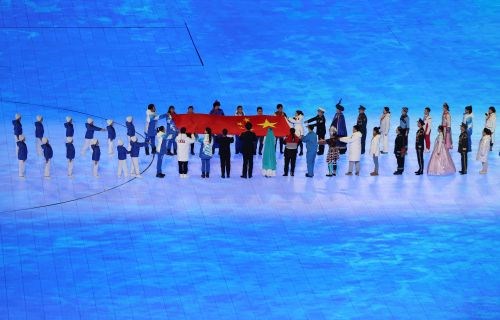
As in 2008, the opening ceremony highlighted all of China’s 56 ethnicities including Uyghurs. It could be interpreted as a response to the criticism on China’s escalated crackdowns in the Xinjiang region. Photo: Maddie Meyer/Getty Images
08.02.2022
It was a different China that welcomed the world at the opening ceremony of the 2022 Beijing Winter Olympics on Friday 4 February 2022 than the China that hosted the 2008 Beijing Summer Olympics 14 years earlier. Compared to 2008, the ceremony was a scaled-down affair portraying a much more understated China with no long sequences highlighting the red dragon’s rich and proud history.
In 2008, China, which in this article is to be understood as the Chinese Communist Party under the rule of the president, introduced itself with an opening ceremony that might go down as one of the most impressive theatrical performances in the history of the Olympic movement. Zhang Yimou, the famous Chinese film maker, was hired by the Chinese Communist Party (CCP) as producer of the ceremony and created an extraordinary, intricately choreographed extravaganza that showcased China and its 5,000-year history to the world. It was a picturesque and highly staged image illustrating Chinas impressive cultural heritage and historical contribution to the world community exemplified by China’s four great inventions: paper, gun powder, the compass, and book printing.
Zhang Yimou was also in charge of the 2022 Beijing opening ceremony and therefore expectations were high in terms of what he and the Chinese organisers had planned for the audience and viewers 14 years on from the opening ceremony in 2008. This time, it was a different spectacle and portrayal of China which was meant to demonstrate how far China has come since they introduced themselves to the world in 2008.
Back then, China was an upcoming political and economic power in need of international recognition and therefore produced an opening ceremony showing a stage imaged of the nation’s historical contribution to the world community. In 2022, China has become a recognised global superpower that no longer seeks entry into the international community, but the state still took advantage of the unique public relations opportunity that the opening ceremony of the Olympic Games is, and in this article, I will highlight some of the most significant national and political messages.
China anno 2022: a technological superpower
One of the big take-home messages from the opening ceremony of the 2022 Beijing Winter Olympics was China’s wish to frame itself as a technological superpower. China demonstrated its high-tech capabilities by composing the centre stage within the stadium as an 11,600 square metres HD LED screen.
The LED technology was especially highlighted in a segment called 'Snowflake' where hundreds of children were running, dancing, and holding illuminated dove props. Beneath the children, shining stars and snowflakes appeared which was activated by their footsteps on the LED screen and “created by artificial intelligence using live-motion capture technology,” as it was stated in the official media guide that was handed out to the commentators at the world’s tv stations. However, this high technology and artificial intelligence is the same kind of technology that the Chinese government uses to enhance its totalitarian control and to monitor and subdue millions of Uyghurs and other Muslim ethnic groups in Xinjiang.
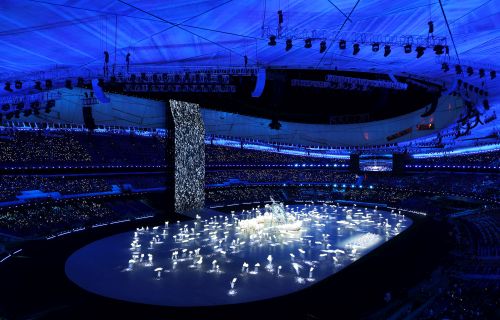
A general view inside the stadium as dancers perform around the large snowflake. Their footsteps on the LED floor are created by never seen before artificial intelligence using live-motion capture technology. Photo: Richard Heathcote/Getty Images
New and innovative technology is the core of China’s strategic plan 'Made in China 2025' that was initiated in 2015. The state-led industrial policy seeks to make China dominant in global high-tech manufacturing. The goal is to reduce the country’s dependence on foreign technology and instead improve and promote Chinese high-tech manufacturers in the global marketplace. And what better way to demonstrate this than by introducing never used artificial intelligence technology through the opening ceremony with billions of viewers worldwide?
Another showcase of China’s technological prowess is their high-speed rail, and viewers of the opening ceremony got a glimpse of the high-speed rail in the introductory video of the ceremony. Before the 2022 Olympics, China launched the world’s first high-speed train with 5G coverage, allowing athletes, journalists, and other attendees to move between the two competition zones of Beijing and Zhangjiakou. There is also a new state-of-the-art live streaming studio on-board that features the world’s first application of 5G+4K/8K+AI technology in ultra-high-definition (UHD) TV for live broadcast on bullet trains. From the beginning of the opening ceremony, it was clear that China under president Xi Jinping wants to portray itself as being at the cutting edge of developing high-tech solutions.
A frontrunner in tackling climate change
The Winter Olympics opening ceremony director Zhang Yimou had promised that the Olympic cauldron would “certainly be different” and would “be unprecedented in the over 100-year history of the Olympic Games.” Few would have thought that one of the most important rituals at the Olympics - the lightning of the Olympic cauldron - would be used as a political statement on climate change.
In the final act of the curtain-raising event, Chinese athletes Dinigeer Yilamujiang and Zhao Jiawen - the two last torchbearers - placed the Olympic torch in the middle of a giant snowflake completing the 2022 Beijing Olympic cauldron. The Olympic torch with its tiny flame eventually became the Olympic flame. The snowflake - a recurring symbol of the ceremony – also symbolises the 91 countries and regions participating in the Games as it is composed of 91 smaller snowflakes.
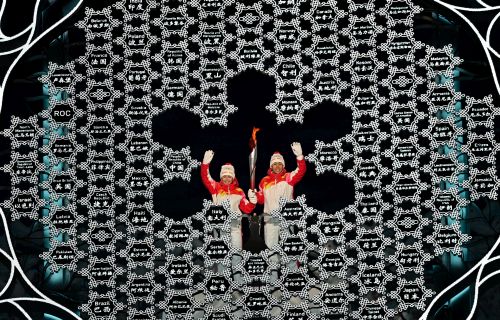 The Olympic cauldron is lit by Dinigeer Yilamujiang, left, and Zhao Jiawen of China during the opening ceremony of the Beijing 2022 Winter Olympic Games. Photo: Ramsey Cardy/Getty Images
The Olympic cauldron is lit by Dinigeer Yilamujiang, left, and Zhao Jiawen of China during the opening ceremony of the Beijing 2022 Winter Olympic Games. Photo: Ramsey Cardy/Getty Images
The size of the Olympic flame was a political statement itself. According to the media guide, it is the first time such a “micro flame” has been used for an Olympic cauldron and it “highlights the efforts China has been making in cutting carbon emissions and promoting sustainability.” Therefore, it also becomes a symbol of China’s pledge to reach net-zero emissions by 2060 with a peak no later than 2030.
“Whether you like it or not, it’s sending a clear message: the cauldron is the world and lighting it is about being environmentally friendly and having low carbon emission,” director Zhang Yimou told People’s Daily, the official Communist Party Central Committee newspaper.
The green commitment was also stated by Cai Qi, president of the 2022 Beijing organising committee, in his speech at the end of the opening ceremony: “With the full support of President Xi Jinping and under the strong leadership of the Chinese government, we have remained committed to a green, inclusive, open and clean approach to preparing and hosting the Games.”
However, as The New York Times writes: “The environmentally unfriendly secret of winter sports is that many competitions take place on artificial snow. China’s water-scarce capital had to go to enormous lengths to make enough of it”. It might also be worth mentioning that as a part of China’s rise to become a global superpower it also became the world’s largest contributor to greenhouse gas emissions according to a study by Rhodium Group from 2021.
Uyghurs present at centre stage
Much of the criticism surrounding the 2022 Beijing Winter Olympics has centred on China’s treatment of the Uyghurs and other mostly Muslim ethnic groups in the north-western region of Xinjiang. In April 2021, Human Rights Watch published a report on the Chinese government’s crimes against humanity, documenting mass arbitrary detention, torture, mass surveillance, cultural and religious erasure, separation of families, forced labour, and sexual violence and violations of reproductive rights against Uyghurs and other Turkic Muslims in the northwest region of Xinjiang. The United States and many international human rights groups have called it a form of genocide constituting “crimes against humanity”.
When the U.S. announced its diplomatic boycott of the Games, White House press secretary Jen Psaki also referred to the People’s Republic of China’s “ongoing genocide and crimes against humanity in Xinjiang and other human rights abuses” as the main reason why no U.S. government officials will attend the Games.
China has long dismissed the criticism and rejected all allegations. And the Chinese state appeared to meet its critics head-on at the opening ceremony. For the much-awaited lighting of the cauldron, the Chinese organisers had chosen female cross-country skier Dinigeer Yilamujiang, born in Altay in the western Xinjiang region, and Zhao Jiawan, a Chinese men’s Nordic combined athlete from China's dominant Han majority. The choice of a person with Uyghur heritage to light the Olympic flame did not escape the notice of and criticism by human rights groups, but for the International Olympic Committee (IOC) it was a “lovely concept”.
NBC’s anchor Savannah Guthrie called the moment “quite provocative [and] a statement from the Chinese President Xi Jinping ... It is an in-your-face response to those Western nations, including the US, who have called this Chinese treatment of that group genocide and diplomatically boycotted these games.”
The demonstrative disregard China showed to the critics of its human rights record was already displayed earlier on in the ceremony.
A highly anticipated moment of the opening ceremonies is the entry of the national flag. Eight children carried the flag into the Bird’s Nest before passing it along a line of representatives from all “walks of life, recipients of national medals and honorary titles, and representatives of 56 ethnic groups from all parts of China,” who were “all ordinary Chinese, passing on the flag hand to hand to express the people's affection for and bond with the national flag,” as it was stated in the official media guide.
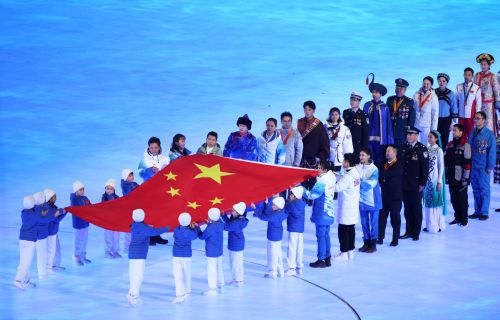 The flag of the People's Republic of China is passed from children to recipients of national medals and honorary titles and representatives of 56 ethnic groups from all parts of China at the opening ceremony of the Beijing 2022 Winter. Photo: Adam Pretty/Getty Images
The flag of the People's Republic of China is passed from children to recipients of national medals and honorary titles and representatives of 56 ethnic groups from all parts of China at the opening ceremony of the Beijing 2022 Winter. Photo: Adam Pretty/Getty Images
The 56 officially recognised ethnic groups in China include Uyghurs, and these scenes at the opening ceremony can easily be seen as China’s eagerness to signal ethnic integration and ethnic equality which is far from reality. For years, human rights groups such as Amnesty International and Human Rights Watch have published reports about the over one million Muslim Uyghurs that have been imprisoned in what is labelled “political re-education camps” in Xinjiang. In recent years the Uyghurs’ resentment has also been fuelled by the widespread belief that the Han Chinese are given the best jobs in the region.
A similar display happened at the opening ceremony of the 2008 Beijing Summer Olympics. Children in national costumes from the 56 different ethnic groups in China carried the national flag into the stadium. It later turned out that the children were not at all representatives from all the different ethnicities, but only from the ethnic group of Han Chinese, which makes up 92 per cent of the population.
Xi Jinping’s geopolitical agenda
Relations between Taiwan, the self-ruled island, and mainland China – which considers Taiwan to be a rogue province that must be brought back under control – has been at a low point for years. Shortly before the 2022 Olympics, Taiwanese sports officials said that they planned to skip the opening ceremony, citing travel issues and the strict COVID-19 countermeasures in place at Beijing 2022. But the IOC intervened and insisted that Taiwan’s Olympic delegation had to participate. Taiwan reversed its decision but urged China not to try to use the Games to suppress Taiwan and undermine the island’s status. But China did not meet that call.
According to Amy Qin, a reporter for The New York Times, the announcers in the stadium used the official “Zhonghua Taipei” to refer to the Taiwan delegation when they entered the stadium during the parade of nations, while announcers from Chinese state-owned tv channel CCTV called the delegation “Zhongguo Taipei.” Zhongguo is the Chinese name for China and referring to the Taiwanese delegation as such implies that the athletes and the island they represent are part of China. Words are one thing but combined with images the messages can be even stronger.
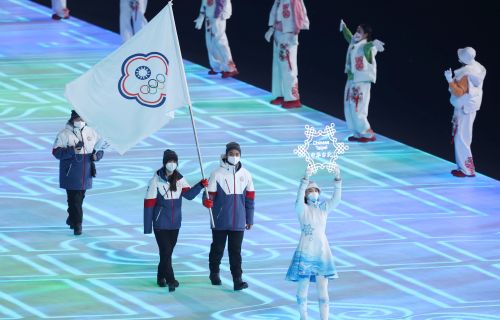 Flag bearers Ping-Jui Ho and Yu Ting Huang of Chinese Taipei as Taiwan is called at the Olympics enters the Olympic stadium. Photo: Alex Pantling/Getty Images
Flag bearers Ping-Jui Ho and Yu Ting Huang of Chinese Taipei as Taiwan is called at the Olympics enters the Olympic stadium. Photo: Alex Pantling/Getty Images
Just as in 2008 there were different television versions of the ceremony: one that was transmitted to the Chinese audience on state-owned CCTV, and one for the foreign viewers. During the parade of nations, the Chinese version of the opening ceremony zoomed in on president Xi Jinping when Taiwan entered the stadium – a definite sign of Xi’s geopolitical aspirations about Taiwan and his plans on a “reunification” with Taiwan and the motherland.
The same thing happened when Hong Kong entered the Olympic stadium. Not only was “Hong Kong” followed by “China” on the placard, but the camera from both television versions also quickly found the Chinese leader once again. Despite Hong Kong’s independent Olympic status, it is first and foremost a part of the motherland for the Chinese state and Xi Jinping’s geopolitical agenda.
One World, One Family
The theme for the opening ceremony was “One World, One Family” and was represented by the image of a single snowflake. According to the official media guide, the theme was based on an ancient Chinese saying which meant “that a truly wise person sees the whole world as a family.” Later on, snowflake placards with the names of the participating delegations formed a giant snowflake and the theme of "One World, One Family" was once again highlighted.
The slogan for the 2008 Beijing Summer Olympics was “One World, One Dream”. 14 years later that dream has become the idea of one world, one family. With this slogan, China tries to waive off the growing criticism from democratic countries over its authoritarian system.
The official motto for the 2022 Beijing Olympics is “Together for a Shared Future” and the dream of one big family standing together for a shared future was also emphasized in the president of the 2022 Beijing organising committee Cai Qi’s speech: “Let us stand together - in solidarity, mutual understanding and mutual support - to deliver a simple, safe and splendid Games (…) Let us work together to add a new chapter to building a community with a shared future for mankind!”
These words can be interpreted as a response to the politics surrounding the 2022 Olympics not least with the staged diplomatic boycottswhich Chinese officials have dismissed as “political posturing and manipulation”.
The 'family' concept is also much loved by international sport where the top leaders always refer to “the football family”, “the great family of volleyball” and not the least “The Olympic family” – as a way to deflect possible internal conflicts and make sure they are not shared outside the 'family'.
In his speech, IOC president Thomas Bach stressed the “mutual understanding” and tried to rise Olympic sport above the geopolitical tensions of the world. Without the slightest reference to human rights as a precondition for sporting values and world peace, he stated that "In our fragile world, where division, conflict and mistrust are on the rise, we show the world: yes, it is possible to be fierce rivals, while at the same time living peacefully and respectfully together. This is the mission of the Olympic Games: bringing us together in peaceful competition. Always building bridges, never erecting walls. Uniting humankind in all our diversity.”
He even called on “political authorities across the globe” to observe their commitment to the Olympic Truce. “Give peace a chance,” Bach said - with a quote from the late Beatle John Lennon whose song ‘Imagine’ were also played during the opening ceremony.
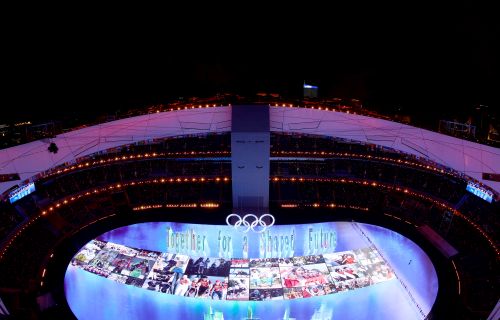 The motto for the 2022 Beijing Winter Olympics revealed at the stadium floor. Photo: Richard Heathcote/Getty Images
The motto for the 2022 Beijing Winter Olympics revealed at the stadium floor. Photo: Richard Heathcote/Getty Images
The idea of 'bringing people together' and 'One World, One Family' also came to light in the segment called 'A Walking Performance of the People'. 76 young, ordinary people from all over the world and of “different races and skin colours” according to the media marched across the stadium floor revealing a 'river of images' of people from around the world dealing with the COVID-19 pandemic. On the two sides of the 'river of images', Chinese knot decorations symbolizing unity and good fortune gradually morphed into the Games' motto, 'Together for a shared future', in both Chinese and English “expressing [China’s] wish for the world.”
The youth is the future
China’s society is rapidly ageing which is seen as a threat to the long-term economic growth as its workforce shrinks and a low fertility rate results in fewer new-borns. In January, China announced that its birth-rate plummeted for a fifth straight year in 2021. The organisers addressed this issue by letting children and young people play a central part in the opening ceremony.
Children were also chosen as bearers of the national flag, as choir-singers of the Olympic anthem, and in the revealing of the Olympic cauldron, just as they were letting a child trumpeter play the melody of 'My Motherland and I' – a very nationalistic and patriotic song written in 1956 during the rule of Mao Zedong emphasising that whoever dares to challenge the Motherland (“if the wolves come”) will be met with “hunting guns”.
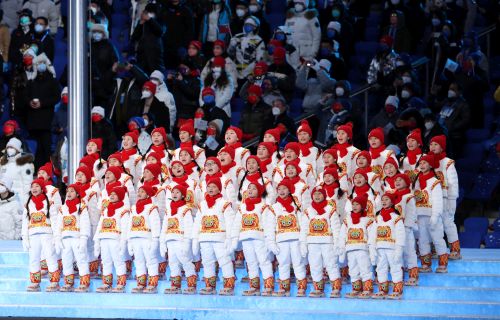 40 children of the Malanhua’er Children’s Choir performed the Olympic anthem which they had learned to sing in Greek after three months of practice according to the media guide. Photo: Lintao Zhang/Getty Images
40 children of the Malanhua’er Children’s Choir performed the Olympic anthem which they had learned to sing in Greek after three months of practice according to the media guide. Photo: Lintao Zhang/Getty Images
Children also played an important role in a video shown during the opening ceremony where little children experienced winter sports for the first time. According to the media guide, this was “thanks to China’s campaign of encouraging 300 million people to participate in winter sports,” and maybe, the media guide stated, this “passion” may “inspire them to one day become the champions of tomorrow!”
Politically, China’s ruling Communist Party has also taken steps to address the declining birth-rate and ageing population, by relaxing its notorious 'one child' policy by first allowing two children in 2016 and since last year as many as three.
A hidden reference to ancient China
At the parade of nations, athletes entered the stadium through a large gate called 'Gate of China' in the media guide, with the Olympic rings hanging above them. The 'Gate of China', according to the media guide, “symbolises that China opens its door to welcome the world to the Olympic Winter Games.”
Historically, the 'Gate of China' has an important place in China’s rich cultural history. During the Ming and Qing dynasties, it was the southern gate of Beijing’s Imperial City situated on the central axis of Beijing, to the north of Zhengyang Gate, and south of Tiananmen. Unlike these two defensive gates, the 'Gate of China' was a purely ceremonial gateway. Originally, the gate was built under the Ming dynasty, and as it was the southern gate of the Imperial City, and 'South' in ancient China was regarded as the most eminent direction, the gate got the status as the 'Gate of the Nation'.
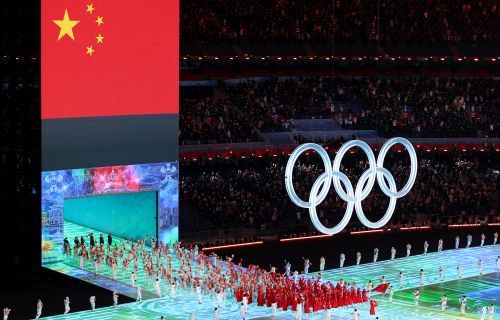 Team China enters the stadium through what was called the 'Gate of China'. Photo: Adam Pretty/Getty Images
Team China enters the stadium through what was called the 'Gate of China'. Photo: Adam Pretty/Getty Images
Its name has changed throughout history as dynasties rose and fell. With the fall of the Qing dynasty in 1912, its name was changed to the 'Gate of China'. It was demolished in 1954 on recommendation from the Soviet Union, and in 1976 a mausoleum was built on the site of the former gate after the death of Chairman Mao Zedong, the Chinese communist and founding father of the People's Republic of China whose leadership resulted in total judicial arbitrariness, mass executions of counter-revolutionaries, whose reform policy behind the so-called 'Great Leap Forward' in 1958-1960 was, in fact, a great leap back with the loss of up to 45 million lives in four years mainly due to famine. Mao Zedong's 'Cultural Revolution' from 1966-1976 was also much more about barbarism than culture. However, the new 'Gate of China' shown at the opening ceremony welcoming athletes from all over the world can only be interpreted as a gate to modern-day China, president Xi Jinping's China who with the CCP's newly approved resolution has consolidated Xi's authority and placed him on the same pedestal as former leaders of the CCP, Mao Zedong and Deng Xiaoping, the only other two leaders who have convened a resolution on the party's history.
Further reading
Bonde, H. (2015). Between tightness and looseness: the politics of the London Games in the light of the Beijing Games. In: D. Hassan, & S. Mitra (red.), The Olympic Games: Meeting New Global Challenges (p. 100-113). London: Routledge. Sport in the Global Society - Contemporary Perspectives.
Bonde, H. (2017). Putin’s “Somocracy” and his Sports-political Forum in Sochi – An essay interpolation of the work of J. A. Mangan. In:P. Horton (Red.), Manufacturing Masculinity: The Mangan Oeuvre – Global Reflections on J.A. Mangan’s Studies of Masculinity, Imperialism and Militarism (s. 363-389). Logos Verlag Berlin GmbH.
Elsborg, S. (2018). Putin's use of sporting events as a domestic policy tool.
Elsborg, S. (2018). Putin’s use of sporting mega-events as an “arena for historical memory” (in Danish).
Elsborg, S. (2021). Beijing 2022: To the moon and back
Elsborg, S. (2022). The political power of the Olympic opening ceremony: Lessons from Beijing and Sochi





